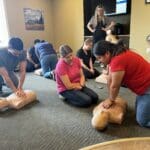CPR (Cardiopulmonary Resuscitation) is one of the most vital skills anyone can learn. But, there are a lot of myths and misconceptions surrounding it. From hands-only CPR to broken ribs, these myths might stop people from acting in an emergency or discourage them from learning. Let’s clear up the confusion! Here are some common CPR myths—and the truth you need to know.
Myth 1: Only professionals can perform CPR.
Reality: Anyone can learn CPR!
According to the American Heart Association (AHA), nearly 70% of out-of-hospital cardiac arrests happen in homes, and immediate CPR from a bystander can double or triple a victim’s chance of survival. Only around 46% of people receive the immediate help they need before professional responders arrive. With proper training, you could be that lifesaver.
Myth 2: You’ll hurt someone by doing CPR.
Reality: Doing nothing is worse than doing CPR!
Studies show that less than 10% of cardiac arrest victims survive without immediate CPR. On the other hand, while chest compressions may cause injury like rib fractures, survival rates significantly improve with immediate CPR. In a study published in the New England Journal of Medicine, researchers found that the long-term benefits of survival far outweigh the risks of injury from chest compressions.
Myth 3: You need to perform mouth-to-mouth for CPR to work.
Reality: Hands-only CPR can save lives too!
A study by the AHA found that hands-only CPR performed by bystanders increased survival rates by 50% in adults who collapsed due to sudden cardiac arrest. Since 2008, the AHA has promoted hands-only CPR for people who are untrained or uncomfortable with rescue breathing. The key is continuous chest compressions—hard and fast in the center of the chest.
Myth 4: CPR is useless after a few minutes.
Reality: CPR buys time until professional help arrives.
For each minute without CPR, the chances of survival drop by 7-10%, according to the AHA. However, if CPR is started within the first few minutes of cardiac arrest, it can double or triple the survival rate. Research published in the Journal of the American Medical Association (JAMA) underscores the importance of early CPR in keeping oxygen circulating until paramedics arrive.
Myth 5: You’ll get sued if you do CPR wrong.
Reality: Good Samaritan laws protect you.
Good Samaritan laws in many countries and U.S. states provide legal protection to individuals who give reasonable assistance to those who are injured or in peril. According to the National Conference of State Legislatures (NCSL), these laws generally shield rescuers from legal liability as long as they act in good faith and are not grossly negligent.
Myth 6: Only adults need to know CPR.
Reality: CPR is for everyone, including teens!
The AHA recommends that all teens and adults should know how to perform CPR. A study by Circulation found that educating high school students about CPR greatly increased bystander CPR rates and improved outcomes in communities. Many schools have now made CPR training a graduation requirement.
Myth 7: You should wait for the AED instead of starting CPR.
Reality: Start CPR immediately while someone else gets the AED!
The AHA emphasizes that the combination of CPR and early defibrillation (using an AED) improves survival chances. A study published in the Resuscitation Journal shows that survival rates can increase to nearly 70% when both CPR and defibrillation are performed within the first few minutes of cardiac arrest.
Myth 8: You no longer have to give breaths during CPR.
Reality: While hands-only CPR is effective in many situations, rescue breaths are still important in certain cases!
Hands-only CPR has been shown to increase survival rates, especially for adult victims of sudden cardiac arrest. However, according to the American Heart Association (AHA), for situations such as drowning, drug overdoses, or for children and infants, traditional CPR with rescue breaths is still recommended. The AHA highlights that while hands-only CPR is great for untrained bystanders, rescue breaths help maintain oxygen levels in cases of respiratory failure.
A study published in the Journal of the American Medical Association (JAMA) indicates that providing rescue breaths in addition to compressions can be critical for infants and children. These groups are more likely to experience breathing-related emergencies, and breaths can make a big difference.
Myth 9: You shouldn’t perform CPR because you might break someone’s ribs.
Reality: A broken rib is better than not surviving.
It’s true that CPR can sometimes cause ribs to crack or break, but that’s not a reason to avoid doing it. According to the American Heart Association (AHA), the goal of CPR is to keep the blood flowing to vital organs. While broken ribs can happen, they are far less dangerous than cardiac arrest, which can be fatal without immediate intervention.
Research published in the Resuscitation Journal indicates that while rib fractures occur in about 30% of CPR cases, survival is always the top priority. A person with broken ribs will recover, but someone who doesn’t receive CPR in time may not.
Myth 10: Incorrect CPR can kill a person.
Reality: Performing CPR, even imperfectly, is far better than doing nothing.
Many people hesitate to perform CPR out of fear they might do it wrong and cause more harm. The truth is, not acting is far more dangerous than making mistakes. According to the American Heart Association (AHA), immediate CPR is crucial for survival. The worst outcome usually happens when CPR isn’t performed at all.
Even if your chest compressions aren’t perfect, they still help keep blood flowing to the brain and vital organs. Studies show that hands-only CPR can double or triple a person’s chance of survival when performed before emergency personnel arrive. There are very few ways you can “harm” a person with CPR—and the risks of not doing it at all are far greater.
The Bottom Line:
CPR isn’t complicated, and it doesn’t require superhuman strength. Learning CPR can turn you into a lifesaver. Don’t let myths stop you from taking action in an emergency. With a little knowledge and training, anyone can step up and make a difference.
Ready to bust more myths? Sign up for a CPR class today and gain the confidence to save lives!




